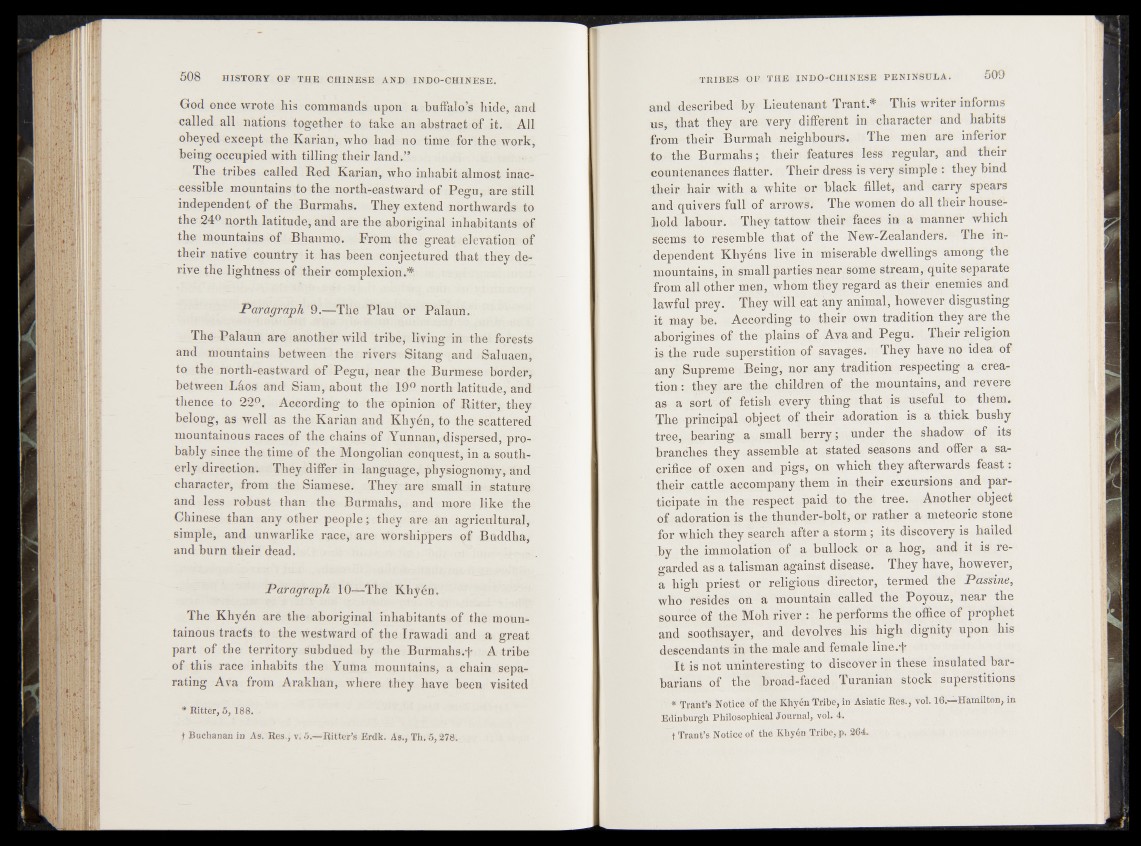
God once wrote his commands upon a buffalo’s hide, and
called all nations together to take an abstract of it. 4 All
obeyed except the Karian, who had no time for the work,
being occupied with tilling their land.”
The tribes called Red Karian, who inhabit almost inaccessible
mountains to the north-eastward of Pegu, are still
independent of the Burmahs. They extend northwards to
the 24° north latitude, and are the aboriginal inhabitants of
the mountains of Bhanmo. From the great elevation .of
their native country it has been conjectured that they derive
the lightness of their complexion.*
Paragraph 9.—The Plau or Palaun.
The Palaun are another wild tribe, living in the forests
and mountains between the rivers Sitang and 3 Saluat«,
to the north-eastward of Pegu, near the Burmese border;
between JAos and Siam, about the 19° north latitude, and
thence to 22°. According to the opinion of Ritter, they
belong, as well as the Karian and Kliyen, to the scattered
mountainous races of the chains of Yunnan, dispersed, probably
since the time of the Mongolian conquest, in a southerly
direction.. They differ in language, physiognomy, Und
character, from the Siamese. They are smalL in stature
and less robust than the Burmahs, and more like fhe
Chinese than any other people; they are an agricultural,
simple, and unwarlike race, are worshippers of Buddha^
and burn their dead.
Paragraph 19—The Khysm',
The Khy^n are the aboriginal inhabitants of the mountainous
tracts to the westward of the Ira wadi and a great
part of the territory subdued by the Burmahs.+ A tribe
of this race inhabits the Yuma mountains, a chain separating
Ava from Arakhan, where they have been visited
* Ritter, 5,188.
f Buchanan in As. Res., v. 5.—Ritter’s Erdk. As., Th. 5,378.
and described by Lieutenant Trant* This writer informs
ffiUi .that they are ttfery > different in character and hahits
from their Burmah neighbours. The men are inferior
to the Burmahs; their features less regular, and their
countenances flatter. Their dress is very simple : they bind
their hair with a whi%M©r black fillet, and. carry spears
and quivers full of arrows. The women do all their household
labour. ThOy tattow their faces in a manner which
&eems. to resemble that'of the -MewLZealanders.- The independent
Khy6ns lkve’rin miserable dwellings among the
mountains, in small parties nearsome stream, quite-separate
fromall other men, whom tti’ey regard as their enemies and
lawful prey. They wll^eht'anyanimal, however disgusting
it may be. According to tlieir Own tradition they are the
aborigines of the plains of Ava and Pegu. Their religion
is the nude superstition of savages. They have no idea of
any Supreme Being, nor any tradition respecting a creation
: they are the children of the mountains; and revere
as a sort“ of fetish every thing that is useful to them.
The principal object of their adoration is a thick bushy
tree,- bearing a small berry; under the shadow of its
branches they assemble at stated seasons and offer a sacrifice
of oxen and pigs, on which they afterwards feast:
their cattle accompany them in their excursions and participate
in the respect paid to. the* tree. Another object
of adoration is the thunder-bolt, or rather a meteoric stone
for which they search after a storm; its discovery is hailed
.by the immolation of a bullock or a bog, and it is regarded
as a talisman against diseased They hate, however,
a high priest or religious director, tertoed The Passine,
who resides on a mountain called the PoyoUz, near the
source of the Moh river : he performs the office of prophet
and soothsayer, and devoltes his high, dignity upon his
descendants in the male and female line.+ m
It is not uninteresting fdc disOoteh in these insulated bat*
barians of the .hroad--fa|©d. Turanian stock superstitions
* TraM’S Noticb of tM&Jiy&n ftffbe, in Asiatic ReB^’Vfoi. i&
Edinburgh Philosophies^,'’Journal, vol.- 4.
. f Trant’s Notice of the Khyen Tribe, p. 264.